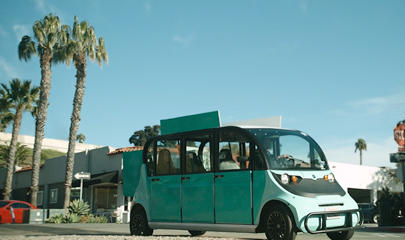Flexible Fleets are on-demand transportation services that help people move around the region. Riders can use these services to reach their destinations or to connect to high-speed transit. The goal of this initiative is to provide affordable transportation choices while improving air quality and advancing the goals of the Regional Plan. There are several types of Flexible Fleets:
- Microtransit shuttles are multipassenger vehicles that carry 4 to 15 passengers and provide rides within a defined service area. Vehicles can be any type of gas or electric car, van, or bus.
- Neighborhood electric vehicles (NEV) microtransit shuttles are a specific type of microtransit that carry up to 5 passengers and offer short trips on a fixed or on-demand route. They are a specific type of low-speed electric vehicle limited to smaller service zones and roads with inclines below 20%.
- Micromobility fleets offer small, low-speed, vehicles such as e-scooters, bikes, and other electric rideables.
- Rideshare includes carpools, vanpools, and pooled ridehailing services such as Uber, Lyft, and taxis that link passengers with available drivers.
- Carshare options offer short-term rental vehicles through companies with fleets of vehicles (such as Zipcar) or individuals who use peer-to-peer systems (such as Turo).
Learn more about specific microtransit services offered in the San Diego region. Flexible Fleet services are typically reserved on-demand through a mobile app or through a hotline. SANDAG and other public agencies work with service providers to ensure there are options for people without a smartphone or credit card.
Implementation Strategy
In efforts to implement the Regional Plan, SANDAG developed a Flexible Fleets Implementation Strategic Plan. The plan identifies priority Flexible Fleet service areas and provides a detailed roadmap for deploying services in a way that is environmentally friendly and makes the region more accessible. Additionally, the Draft 2025 Regional Plan includes 36 Flexible Fleets service areas.
The Flexible Fleets Task Force bridges strategic plan recommendations with pilot implementation. The group discusses pilot opportunities, partnerships, and potential hurdles while sharing best practices, reviewing case studies, and evaluating industry trends. Regionwide Flexible Fleets data can be viewed on SANDAG’s Open Data Portal.
Flexible Fleets Pilot Grant Program
At SANDAG, we are committed to expanding shared mobility travel choices, enhancing transit connections, filling transit gaps, improving air quality, and advancing the goals of the Regional Plan. The Flexible Fleets Pilot Grant Program will provide $4.5 million for projects that help achieve these goals.
Throughout 2025, SANDAG presented the program and collected feedback from working groups and Policy Advisory Committees. In 2026, SANDAG will release a Flexible Fleets call for projects inviting local, state, federal, and tribal governmental agencies, military institutions, and transit districts to submit projects for funding consideration during the 90-day application period. Grant agreements will be issued in 2026.
Contact grantsdistribution@sandag.org for more information.




















